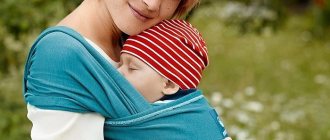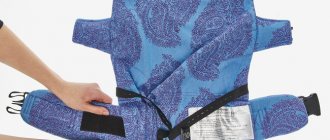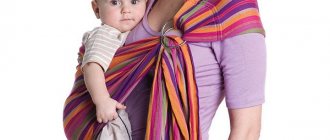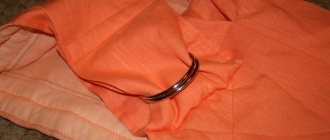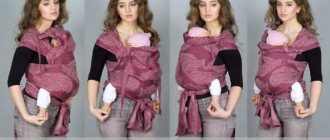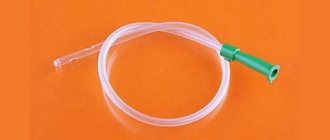How to tie a baby sling scarf
Walking with a stroller is a classic way for a mother and baby to move, but you shouldn’t limit yourself to just this option. Strollers are not always comfortable, they are difficult to take down and up stairs, they are inconvenient to carry into transport, and not all children lie quietly in a stroller.
A newborn baby needs mother's constant presence. The warmth of the mother gives him a feeling of security, the child becomes calmer, cries less, and falls asleep easier. What to do if it’s hard to carry your baby in your arms all the time? How to do household chores if your newborn often cries and cannot lie quietly without your attention? There is a universal invention - a sling.
The sling is suitable for both babies and older children. The main task of a sling is to free up your hands and distribute the load well on your shoulders, back and hips so that a woman’s posture does not suffer from constant carrying of weight.
There are several sling designs, which you can see in the table.
| Design | Description | Material |
| Sling with ring | Worn on one shoulder and more suitable for babies who can only lie down. Disadvantages - to avoid bending, you need to change the position of the strap from one shoulder to the other more often | Most often, ring slings are made from calico, satin or hand-woven cotton fabric (the latter type of cotton fabric is most preferable, since the woven fabric is well ventilated, highly wear-resistant and drapes well, which is important for adjusting the sling). There are also slings with silk rings |
| May-sling | Good for children from six months, but not suitable for small children: it can only be used in a sitting position. It is a rectangle to which four wide straps are sewn | The fabric used is dense but breathable, often decorated with appliqués, embroidery, rhinestones, and complemented with patch pockets (behind the child’s back) |
| Sling scarf | Universal design, can be used both as a cradle and as a backpack for sitting children. Will serve your baby from birth until the moment you stop carrying him in your arms | There are knitted and woven. The former are capable of stretching, the latter are not. |
| Sling pocket | Similar to a sling with a ring. Has a fixed size, clasps, carabiners, buttons. Suitable for older babies, since the sling does not have a free end, which can be used to cover a sleeping child from the sun or wind | Lightweight slings-pockets - made of satin, calico, and stretch fabrics with a high cotton content. Warmer ones - made of fleece and polar |
| Sling backpack | It looks like a backpack - a kangaroo, but at the same time the child takes the correct position, the legs do not dangle, and the crotch is not compressed. Typically allows the baby to be seated in three different positions depending on age | Natural fabrics and reliable fasteners |
Scarf slings come in different lengths and are made from different materials. This is a strip of fabric (usually elastic) 50-80 cm wide and 2 to 5 meters long.
A long scarf is great for long walks - two wide straps will distribute the weight of the child on the mother’s shoulders, and it will not be difficult to carry even a large baby.
The average scarf has fewer ways to tie. An option for short trips to the yard or to the store.
A short rebozo sling is tied only on one shoulder. It will be comfortable for a newborn to sleep in it, but the position of the sling will have to be changed periodically. Carrying a child will be harder due to less load distribution, but this tube scarf is compact and easy to put on.
Let us examine in detail how to tie a scarf for newborns.
Babywearing clothes
Even when positioned correctly, the baby may still experience discomfort due to incorrect clothing.
When placing your baby in a sling, you should not put him in rompers. It is better to choose soft pants that will not interfere with spreading your knees to the sides. Also, do not dress your baby too warmly. This may cause the baby to overheat.
For walks, it is better to use special adult sling jackets or sweaters that are worn over the sling.
Also suitable are items for pregnant women or just a slightly larger size.
It is worth remembering that a child is pressed tightly against an adult’s clothing, so it should be without small parts, clean, pleasant to the touch, not scratchy and made of natural hypoallergenic fabrics.
What is a sling scarf
This is a rectangular piece of fabric ranging from two and a half to seven meters in length. The width of different models varies from half a meter to a meter. The larger the sling size, the more variable the winding methods.
The advantage of a sling scarf over other models is its variability. The weight can be distributed evenly over two shoulders and the baby can be placed behind the back. Each woman chooses ways to tie a sling scarf that are suitable for her and her child.
There is only one drawback - the process of putting it on will initially take a lot of time. It will take time before the mother can wrap the sling scarf correctly.
How to choose: purchasing recommendations
Designer models from famous manufacturers cost up to several tens of thousands of rubles. But, in essence, this is just a piece of fabric with a mandatory set of physical properties. When choosing a sling scarf, you need to focus on the following parameters:
- quality of material - natural threads and elastic fabric will cope with their task, even if the sling was sewn in China or Uzbekistan;
- size - you need to buy a sling according to the parameters of the largest family member who will use it, and with the prospect of carrying a baby up to two years;
- aesthetics - optimally double-sided weaving, in which the sling scarf will not have a reverse side;
- color - if it is not possible to purchase several models, it is better to choose your favorite or neutral color that will fit into your wardrobe;
- composition and density of the fabric - ideally, you should have at least two scarves to wear in hot and cold weather, but for winter it is better to purchase special clothes to wear over a sling.
Fabric for sling scarf
It is advisable to choose a sling made from natural materials - linen, cotton or wool. The secret of a proper sling is in the weaving of the threads. This cut will stretch well diagonally. Types of woven fabrics used for sewing sling scarves:
- simple plain or taffeta weaving makes the product durable, elastic and breathable, while the fabric has a smooth matte texture;
- diagonal (twill, kiper) weaving - such fabrics are softer, stretch diagonally, the threads form a diagonal pattern;
- double diagonal weaving (herringbone pattern) characterizes the ideal fabric for a sling - it is elastic diagonally, dense, holds its shape well, and is suitable for carrying heavy children;
- jacquard weaving is dense, looks the most aesthetically pleasing, and allows you to create unique double-sided patterns on the canvas.
Read also
Ingrown toenail in a child: causes of pathology and treatment methods, how to avoid complications
Knitted fabric can also be used to make a sling. A knitted sling scarf is easier to handle, but due to the increased elasticity of the fabric, it may sag. Interlock thread weave is the best option for a knitted sling scarf. It holds its shape well and has no seamy side.
It is not recommended to wear children heavier than ten kilograms in knitwear.
Dimensions
How to choose a sling scarf of the required length? A simple rule that allows you to focus on your own parameters: add zero to your clothing size - you get the length of the scarf in centimeters.
- Size 42 - 420 cm.
- Size 44 - 440 cm.
- Size 46 - 460 cm.
- Size 48 - 480 cm.
- Size 50 - 500 cm.
The size of a sling scarf is its length in decimeters.
Most slings have bevels to make the knots more aesthetically pleasing when worn. The sharper the bevel angle, the more beautiful the ends of the tied sling look, and the smaller its usable area. Therefore, the length of the canvas is determined along one edge of the product or from one obtuse angle to another.
How to choose winding size:
- a simple cradle and on the hip - all sizes are suitable: from 2 to 8, 270-570 cm;
- cradle, simple cross and cross above the pocket - suitable sizes: from 5 to 8, 420-570 cm;
- double rebozo, a simple backpack and a backpack with a top - suitable sizes: from 6 to 8, 470-570 cm.
You can correct the excess length with an additional turn of fabric around the waist, so it is better to choose the larger of the two sizes.
The width of the sling depends on the age at which the mother plans to carry the baby. A narrow canvas up to half a meter wide is suitable for carrying a baby. It will be difficult to accommodate a grown-up baby comfortably, and even provide a hood. The optimal width of the sling scarf should exceed the height of the child.
Ways to wind a sling scarf: 5 convenient options (+ video)
A woman can use step-by-step instructions from the Internet on how to wear a sling scarf correctly, get help from more experienced friends, or come up with a way to wear it herself. The sling will accompany the mother and baby from birth until the child himself refuses to travel in this way.
Before wrapping a sling scarf for wearing newborns, you need to consult a pediatrician to determine the most physiological position. There are many ways to tie a sling scarf.
Cradle: from birth
You can start carrying your baby in a horizontal position from the first day of life. How to make a winder for newborns:
- the canvas is folded across;
- The middle of the cut is applied to the body at waist level, and the ends are drawn back, crossed behind the back and placed on the shoulders. Then they are crossed again under the hammock formed from the central part of the cloth;
- the remaining ends are wrapped around the waist and tied at the back;
- The fabric should not twist anywhere.
The baby lies in the resulting pocket in a horizontal position so as to be pressed tightly against the mother’s body. Correct position:
- the head is fixed and raised above the body;
- the back is rounded;
- knees are bent;
- The buttocks should be below the knees.
The fabric will support the baby's back and knees. The length of the sling scarf required to wrap the cradle depends on the size of the child.
Cross above the pocket: for an older child
This carrier is suitable for a newborn and an older child. How to wear:
- the scarf is straightened and applied to the stomach in the middle, and the ends are brought behind the back and crossed, as in the previous winding;
- the fabric is pulled up so that the lower part of the fabric fits tightly around the waist, and the upper part is above the chest;
- the loose ends are crossed on the stomach, but, unlike the cradle wrap, they do it over the pocket. Tied in a knot on the back;
- the child is placed on the shoulder and carefully lowered into the resulting pocket;
- the lower side is tucked between the child and the mother and pulled up from the inside;
- when the baby is already sitting in the sling, the fabric needs to be tightened and the knot tied.
- the whole body is pressed tightly against the mother;
- the head is fixed and located at chest level so that the mother can see the baby’s face;
- the back is rounded, without lumbar deflection;
- legs apart and bent at the knees - “frog” pose;
- The lowest part of the child’s body is the butt.
The baby does not sit in such a winding - he is tied to the chest. His own spine does not receive any load, and the natural center of gravity of the tandem is preserved.
Kangaroo: from birth
How to put on a sling in the kangaroo position:
- The child is placed in the center of the sling across the cloth. The lower edge is pulled between its legs;
- take the baby in your arms and press him to the chest so that the fabric of the sling is stretched;
- The edges of the panel are removed behind the back and the fabric is twisted. Then they throw it forward;
- the panels are pulled over the pocket and a flat knot is tied under the baby’s bottom;
- The ends are wrapped around the waist and tied again.
The position of the child should be the same as in the previous winding.
Thigh wrap: from 3 months
An older baby can be carried in a sitting position by wrapping it comfortably on the hip. This carrier is suitable for carrying a child from three months (the baby begins to confidently hold his head).
- The middle of the sling is draped over one shoulder.
- The ends are crossed at the opposite hip, wrapped around the waist and tied in a knot.
- The child is seated at the intersection of the fabrics, and the fabric is straightened along the back.
- The canvas should support the baby so that he does not fall.
From this winding you can often take the baby out of the sling so that he can run around. It is important to periodically change the shoulder on which the load falls.
Double rebozo on the back: from 3 months or six months
Back wraps are suitable for children who can already sit confidently. This is usually 6 months and older.
- We sit the child on a chair or armchair in a sling fabric.
- We twist the top edge of the scarf under the baby's arms so that the fabric does not slip out.
- We take the child by the forearms and place him on his back.
- Go to the wall and rest your butt against it so that the baby doesn’t slip. Important at first when using winding.
- Two pieces of fabric come out of the armpits: one is short, the other is long. We put the short fabric on our shoulder, draw the long one along our torso, bring it behind the baby’s back and place it on the other shoulder.
- We adjust the lower side of the sling, giving the child a physiological position: the butt is sagging, the knees are raised.
- Adjust the tension of the fabric edges. The result should be a position in which the fabric is completely straightened across the torso, and two pieces hang over the shoulders.
- Place the straps that hang from the shoulders behind the back and cross them under the baby’s bottom and legs.
- Tie at the front with a double knot.
Read also
How to properly potty train a child: the experience of mothers with many children and the opinion of pediatricians
My sling in front
And this instruction shows how to tie a May Sling for an older child. In this form, you can carry babies 4-5 months and older.
- The first few points are identical to how babies are carried. The difference lies in the placement of the crumbs.
- When the baby sling is already tied and lies like an apron on your lap, take the baby and place it on your stomach. Spread the baby's legs wide apart. Make sure that the child is positioned strictly in the middle.
- Now cover the baby's back with the May-sling cloth and repeat all the steps from the previous instructions.
- When you pull the harnesses out from behind and cross them over your baby's back, pass the ends under your baby's knees and then behind your back.
- Tighten 2 knots, straighten out all the folds and make sure that the child is comfortable.
Children over six months old do not have to hide their hands. To do this, it is enough to correctly adjust the height of the panel by turning the bottom edge several times.
How to make a sling scarf yourself: sewing instructions
You can even sew a sling yourself from the fabric you like. Any piece of fabric that is suitable in size and weaving properties of the threads is suitable for use as a sling.
Fabric selection
The fabric can be purchased at a sewing store. It should be natural, dense and elastic.
For summer - cotton, linen, viscose. For winter - half-wool, lint-free fleece. Satin will not work because it is slippery.
Choose stretch fabrics for children of light weight: they are soft and stretch well. As the baby's weight increases, the sewn carrier will stretch more and begin to sag. This must be taken into account.
Dimensions
The required footage is calculated from the size of the mother plus half a meter for bevels on each side. Some fabrics shrink when washed - this must be taken into account when choosing a fabric. For elastic fabric, make the width 0.5-0.55 m. For dense fabric - from 0.7 to 0.75 m. In general, the length will be in the range of 5-5.5 m.
Sewing
The shape of the sling is chosen depending on the fabric used and your taste. These are: a parallelogram, a rectangle with blunt or rounded ends and a rectangle with narrow ends - a “spindle”. The “spindle” is suitable for dense material - it will be more convenient to tie and the knot will not be so huge.
It is better to use whole fabric, not from flaps: this way you will get rid of unnecessary seams that can put pressure on the child’s spine and on the mother.
Fold the edges of the fabric around the perimeter and sew them using a sewing machine. You can make a pocket in the center - this convenient little thing will allow you to put something with you, as well as quickly find the center of the sling.
Sling scarf or sling with rings: what to choose?
A ring sling is a fabric up to two and a half meters long, with two rings built into one end. This sling is worn on one shoulder, threading the other end of the fabric through the rings. Some models have sides that are sealed with foam inserts. A sling with rings involves carrying a child from birth in a horizontal position, sitting on the chest, behind the back and on the hip. It is very easy to use, but compared to a sling scarf, it is less versatile.
When choosing between these two types of slings, you should focus on the distance of the planned walks and the child’s height:
- ring sling is ideal for carrying a baby around the house;
- the lack of tight winding makes this sling suitable for going out in the heat;
- it is convenient to carry an older child over short distances, who will often get out of hand;
- at the same time, carrying a baby for a long time without the ability to transfer the rings from one shoulder to the other in a sling with rings can become torture;
- The mother's health condition, in which shifting the load to only one side is unacceptable, also becomes a contraindication to wearing a ring sling.
For long walks with a large baby, it is better to choose a sling scarf.
After giving birth, a woman can lead as active a lifestyle as she wants. A sling scarf will allow you to move freely around the city, travel, even go to work, and your baby will always be nearby. It is comfortable for the baby, frees up the hands and gives the young mother access to the world. To learn about other types of devices for carrying children, read: “Types of slings for newborns: which one to choose?”
What's good about a sling?
Like any thing, May-sling has its advantages. Firstly, the baby is always as close to her mother as possible, which is important for mental development.
At the same time, the mother’s hands remain free. She can easily do household chores.
If you like long walks, live in a high-rise building without an elevator, or often travel by public transport, you simply cannot do without a fabric carrier.
Other advantages of May-sling:
- very easy to learn;
- light and comfortable;
- quickly removed and put on;
- perfectly fixes the child in close proximity to the mother;
- the baby’s weight is evenly distributed on the adult’s back and both shoulders;
- reliable straps allow you to carry the baby on your back and not be afraid that it will fall out;
- the length of the straps is adjustable, and the wide hood hides the child from strangers;
- you can safely feed your baby on the street and no one will notice.
How to tie a sling scarf: Cross over pocket with spread legs
Age: from birth (the spread of the legs varies depending on the age and tone of the baby; for premature babies or children with hypertonicity, the placement of the legs inside the pocket is recommended) Length of the sling scarf: from 4.2 m with a knot at the back, from 4.7 m with the tails brought forward
This winding is the most universal; the baby’s weight is felt the least in it, so this winding is the best for vertical carrying.
Find the middle of the scarf, apply the middle of the scarf to your chest.
Take one of the panels by the top edge (side), pass your elbow over it, wrap the panel around yourself from behind and place it on the opposite shoulder. With this method of winding, the scarf will not twist, and in addition, you can wrap the scarf with one hand, even if you have a child in your arms.
Gather the panel with a small accordion, starting from the edge closest to the neck, to make a neat plait.
Do the same with the other panel.
The cords on your shoulders are the panels of the cross, the panel on your chest and stomach is the pocket. Carefully pull up the edges of the panels and the middle, tightening the pocket around yourself.
Gather the pocket from the top edge to the bottom and pull it out a little so that when stretched it reaches your waist. Place the baby on your shoulder, put your free hand under the pocket below, and catch the baby's legs.
Spread the pocket fabric over the child's back and bottom from the knees to the child's neck or to the shoulder blades if the child holds his head well and you do not intend to hide his arms inside.
Spread your baby's legs to a comfortable width for him. Tuck the bottom edge of the pocket deep under the baby's bottom so that the bottom edge of the pocket is between you and the child, and the child's knees are higher than the bottom. The legs should not hang like in a kangaroo backpack!
Pull up the panels, first one, then the other. Start from the edge closest to the neck and pull up along the entire width, gathering the panel and not loosening the tension. The child should be well attracted to you in your pocket. You should not feel any slack in the fabric on your back. Pay special attention to the top and bottom sides. Pull the panel upward from behind the shoulder, not down the shoulder. This will make adjustments easier.
Press the well-stretched cloth with your knees. If necessary, further tighten the bottom side so that the child's knees are higher than the butt and the butt falls into the pocket.
To better attract the child with the inner pocket, pull both panels, releasing the child. Attention! Be careful when making this move. To be on the safe side, you can lean back.
Pass the strips over your baby's knees and cross them under his butt. Pass the panels back under the child's legs.
Tie the ends of the scarf at the back with a double knot, or wrap it around the waist, bring them forward and tie them with a double knot under the baby's bottom. The wrap around the waist provides extra support, helping to take some of the baby's weight off your shoulders and back. N.B. If you are going to straighten the panels, do not tie a double knot, but tie a temporary single one.
To make sure that your baby’s butt is deep in the pocket, grab his shins and lift them up, slightly moving your baby’s knees together.
Read also
A child’s eyes are festering: first aid at home and the use of medications
This is what the winding looks like from the front, side and back:
Pay attention to the position of the child inside the sling: the knees are higher than the butt, the legs are spread at a small and comfortable angle for the child. The back is rounded, the spine is level.
You can read more about the position of a newborn in a sling scarf here >>
This type of winding is especially suitable in hot weather; on cooler days, the scarf panels can be spread over the child. Also, with the panels straightened, it is easier to carry older, heavier children.
To straighten the fabric over your baby's back, find the lower of the two crossed panels. Grasp its upper edge under the child’s bottom and pull it over the back, if necessary, cover the head from the back of the head. All folds remain under the child’s leg; the fabric on the back should be well stretched.
Drive the resulting slack to the knot.
Do the same with the second panel. IMPORTANT! You should always see the baby's face!
Now tie the double knot again. If the child does not sleep or protests against the cloth on his head, remove it.
Also, with such a winding it is convenient to breastfeed, instructions are here >>>, and you can take out and place the baby in the sling without unwinding the sling, instructions are here >>>.
In a position behind your back
Children one year of age and older are most often treated this way. This should not be done before, since a smaller child constantly needs the vigilant control of his mother. If you don't know how to tie a May Sling, just follow our instructions:
- Take the May Sling by the lower straps and tie it at the back of your waist, inside out, so that the fabric covers your butt.
- Now place the baby on your hip. His legs should be apart and slightly “hugging” you at the waist.
- Holding the baby, bend forward while moving the baby onto your back.
- Without changing your position, reach for the shoulder straps (they lie on the floor) and cover the baby with the cloth on top.
- Continuing to hold the child with one palm, throw the straps over your shoulders with the other.
- Pull the harness so that the baby is pressed tightly against you from behind.
- Place the straps under your arms. You can cross them on your chest, however, not everyone likes this.
- Cross the harnesses over the child's back. Note! Not under the buttocks, but on the back!
- Now pull the straps under the baby’s knees and bring them forward.
Tie with two strong knots on the stomach. Smooth out all wrinkles and irregularities.
Instructions for slings BY CHILD'S AGE
For a newborn baby
For a baby from 3 months of age (the cervical vertebral curve is developed, the baby holds his head confidently)
- Sling scarf, winding “Cross over pocket” (“CNK”) from 4.2 m
- Sling scarf, winding “Truncated CNC” from 3.5 m
- Sling scarf, winding “Cradle in CNK” from 4.2 m
- Winding the sling-scarf “Cross under the pocket” (“CPC”) from 4.2 m
- Sling scarf, winding “Cradle in a simple (double) cross” from 4.2 m
- Sling scarf, Kangaroo wrap from 3.5 m
- Sling scarf, winding “Cradle in Kangaroo” from 3.5 m
- Sling scarf, winding “Kangaroo on the hip” from 3.5 m
- Sling scarf, winding “Cradle in a cross on the hip” from 3.2 m
- Sling scarf, winding “Robin” (“With a loop on the hip”) from 3.5 m
- Sling scarf, winding “Backpack” from 3.5 m
- Sling scarf, Rebozo winding from 2.5 m
- Sling scarf, winding “Cradle in rebozo” from 2.5 m
- Sling scarf, winding “Rebozo on the hip” from 2.5 m
- Sling scarf, winding “Rebozo on the back” from 2.5 m
- Vertical position on mother's stomach in a sling with rings
- Vertical position on the side, on the hip, on the mother’s back
- Horizontal “cradle” position in a sling with rings
- Sling with rings on mom's shoulder
- May-sling - vertical position on mother's stomach
- Horizontal position "Cradle" in a sling
- Back winding of May sling
- Sling pocket
For a baby from 4-6 months of age (the cervical vertebral curve is developed, the baby confidently holds his head, independently rolls over from his back to his tummy and back)
- Sling scarf, winding “Cross over pocket” (“CNK”) from 4.2 m
- Sling scarf, winding “KNK on the back” (“Backpack from under the arms”) from 4.2 m
- Sling scarf, winding “Truncated CNC” from 3.5 m
- Sling scarf, “Semi-KNK” winding from 3.5 m
- Sling scarf, winding “Cross under the pocket” (“CPC”) from 4.2 m
- Sling scarf, winding “Simple cross” (“Double cross”, “Cross to cross”) from 4.2 m
- Sling scarf, winding “Cradle in CNK” from 4.2 m
- Sling scarf, winding “Cradle in a simple (double) cross” from 4.2 m
- Sling scarf, Kangaroo wrap from 3.5 m
- Sling scarf, winding “Cradle in Kangaroo” from 3.5 m
- Sling scarf, winding “Kangaroo on the hip” from 3.5 m
- Sling scarf, “Cross of Eight” winding from 3.5 m
- Sling scarf, winding “Reinforced (strengthened/compacted) rebozo” from 3.5 m
- Sling scarf, winding “Reinforced Rebozo on the back” (winding RRRR - Rear Reinforced Rebozo Rucksack carry)
- Sling scarf, winding “Cross on hip” from 3.2 m
- Sling scarf, winding “Cradle in a cross on the hip” from 3.2 m
- Sling scarf, winding “Robin on the hip (“With a loop on the hip”) from 3.5 m
- Sling scarf, winding “Backpack” from 3.5 m
- Sling scarf, Jordan wrap
- Sling scarf, winding “Truncated double rebozo” from 3.5 m
- Sling scarf, Rebozo winding from 2.5 m
- Sling scarf, winding “Cradle in rebozo” from 2.5 m
- Sling scarf, winding “Rebozo on the hip” from 2.5 m
- Sling scarf, winding “Rebozo on the back” from 2.5 m
- Vertical position on mother's stomach in a sling with rings
- Vertical position on the side, on the hip, on the mother’s back
- Horizontal “cradle” position in a sling with rings
- Sling with rings on mom's shoulder
- May-sling - vertical position on mother's stomach
- Horizontal position "Cradle" in a sling
- Back winding of May sling
- Sling pocket
- May-backpack - position on mother's stomach
- May-backpack - position on mother's back
For a baby from 6-8 months of age (the lumbar curve of the spine is developed, the baby sits confidently independently for a long time)
- Sling scarf, winding “Cross over pocket” (“CNK”) from 4.2 m
- Sling scarf, winding “KNK on the back” (“Backpack from under the arms”) from 4.2 m
- Sling scarf, winding “Truncated CNC” from 3.5 m
- Sling scarf, “Semi-KNK” winding from 3.5 m
- Sling scarf, winding “Cross under the pocket” (“CPC”) from 4.2 m
- Sling scarf, winding “Simple cross” (“Double cross”, “Cross to cross”) from 4.2 m
- Sling scarf, winding “Cradle in CNK” from 4.2 m
- Sling scarf, winding “Cradle in a simple (double) cross” from 4.2 m
- Sling scarf, Kangaroo wrap from 3.5 m
- Sling scarf, winding “Cradle in Kangaroo” from 3.5 m
- Sling scarf, winding “Cross on hip” from 3.5 m
- Sling scarf, “Cross of Eight” winding from 3.5 m
- Sling scarf, winding “Reinforced (strengthened/compacted) rebozo” from 3.5 m
- Sling scarf, winding “Reinforced Rebozo on the back” (winding RRRR - Rear Reinforced Rebozo Rucksack carry)
- Sling scarf, winding “Cross on hip” from 3.2 m
- Sling scarf, winding “Cradle in a cross on the hip” from 3.2 m
- Sling scarf, winding “Robin” (“With a loop on the hip”) from 3.5 m
- Sling scarf, winding “Backpack” from 3.5 m
- Sling scarf, Jordan wrap
- Sling scarf, winding “Double rebozo” (“Double hammock”) from 4.2 m
- Sling scarf, winding “Truncated double rebozo”
- Sling scarf, Rebozo winding from 2.5 m
- Sling scarf, winding “Cradle in rebozo” from 2.5 m
- Sling scarf, winding “Rebozo on the hip” from 2.5 m
- Sling scarf, winding “Rebozo on the back” from 2.5 m
- Vertical position on mother's stomach in a sling with rings
- Vertical position on the side, on the hip, on the mother’s back
- Horizontal “cradle” position in a sling with rings
- Sling with rings on mom's shoulder
- Vertical position on mother's stomach in a May-sling
- Cradle in May-sling
- Vertical position on mother's stomach in a sling
- Horizontal position "Cradle" in a sling
- Back winding of May sling
- Sling pocket
- May-backpack - position on mother's stomach
- May-backpack - position on mother's back
- Ergonomic backpack on mom's stomach
- Ergonomic backpack on mom's back
- Ergonomic backpack on mom's hip
Precautionary measures
When using a sling, you must adhere to a number of rules to protect your baby from danger:
- do not cover the baby’s face;
- do not make sudden movements or bends;
- do not allow potentially dangerous things within the child’s reach;
- do not use a sling instead of a car seat;
- do not drink hot drinks when the baby is in a sling;
- do not wear uncomfortable shoes or high-heeled shoes;
- do not forget about the child when opening doors, passing through doorways and turning corners;
- do not run around with a strapped baby without special care;
- do not insist on a sling if the baby protests;
- Don’t forget to consult with your pediatrician about the possibility of using a sling if there are any abnormalities in the child’s physical health.
Learning how to wrap a sling scarf correctly seems like a difficult task. And sometimes there is a temptation to choose a different type of sling, one that is easier to use. However, when choosing, it is worth considering that it is by winding the sling scarf that the tension in each centimeter of the fabric supporting the child is regulated.
